
Carabus auratus, the golden ground beetle, is a species of ground beetle in the genus Carabus. This species is native to central and western Europe and has been introduced into North America.

Carabus nemoralis is a ground beetle common in central and northern Europe, as well as Iceland and Canada. While native to Europe, it has been introduced to and is expanding its range throughout North America.

Carabus intricatus, the blue ground beetle, is a species of ground beetle found in Europe.
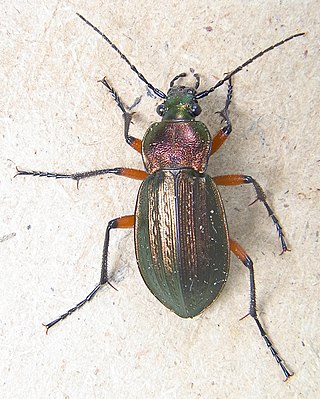
Carabus arcensis is a species of ground beetle in the family Carabidae. It is found in the Palearctic.

Carabus auronitens is a species of beetle in family Carabidae which was described by Johan Christian Fabricius in 1792.
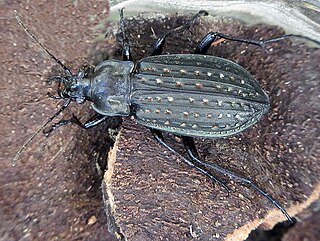
Carabus clatratus is a species of beetle widespread in the Palearctic.

Carabus smaragdinus is a species of beetle belonging to the family Carabidae.
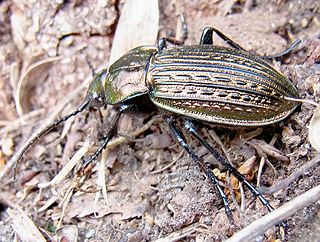
Carabus ulrichii is a species of ground beetle from the family Carabidae originating from the Central Hungarian Basin and found in Bulgaria, the Czech Republic, Germany, Great Britain, Hungary, Luxembourg, Moldova, Poland, Romania, Slovakia, Ukraine, and all of the republics of the former Yugoslavia. They are coloured black, with a green pronotum. The species formation happened in Pleistocene.

Carabus violaceus, sometimes called the violet ground beetle, or the rain beetle is a nocturnal species of a beetle, from the family Carabidae.
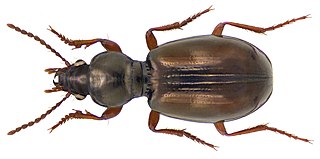
Miscodera arctica is a species of beetles in the family Carabidae, the only species in the genus Miscodera. It is circumpolar in distribution, predominantly northern, with outliers in New Hampshire and Maine in the continental U.S. Its relationships have been long disputed. Here it is placed in subfamily Broscinae. While it certainly belongs to the more advanced ground beetles, it was alternatively placed in the subfamily Trechinae.

Carabus scabrosus, common name huge violet ground beetle, is a species of beetles of the family Carabidae.
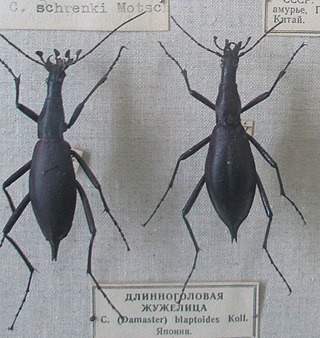
Carabus blaptoides is a species of ground beetle in the family Carabidae that can be found in Japan and Russia. The species are black coloured, but could have either purple or green pronotum.
Carabus cristoforii is a species of black ground beetle from family Carabidae that lives in Andorra, France and Spain.

Carabus loschnikovii is a species of ground beetle in the family Carabidae. The species is found in the Siberian mountain forests, alpine meadows, and tundra of Northeastern European Russia, the Western and Central Urals, and mountains of Southern Siberia and Northern Mongolia.
Carabus obsoletus is a species of black-coloured beetle from family Carabidae, found in Czech Republic, Hungary, Moldova, Romania, Slovakia, Ukraine.
Carabus paraysi is a species of ground beetle in the family Carabidae. It is found in eastern Europe.

Carabus pedemontanus is a species of beetle from family Carabidae, found in France and Italy.
Carabus rothii is a species of ground beetle in the family Carabidae. It is found in Eastern Europe.
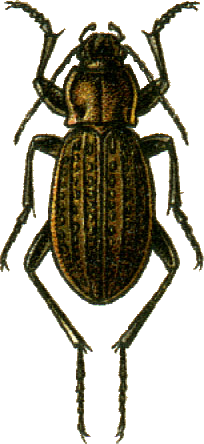
Carabus maeander is a species of beetle in the family Carabidae. The species fly in May and June, are black in colour and 15 to 23.5 millimetres long. It is found in northeastern United States and both central and southern Canada. The species is also found outside of North America. In Russia, it is found in eastern Siberia while in Japan it is known from Hokkaido and Kunashir Islands. It also exists in South Korea.
Carabus chamissonis is a species of ground beetle in the family Carabidae. It is found in tundra regions across northern Canada and Alaska, as well as isolated populations on Mount Washington, New Hampshire and Katahdin in Maine. This is a species of open, dry tundra environments - generally better drained than those occupied in the Arctic by Carabus truncaticollis















